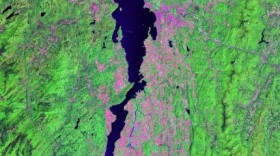Vermont U.S. Senator Patrick Leahy has announced that money is available from the recently enacted Farm Bill to help improve agricultural water quality in one of the problematic watersheds that drain into the Mississquoi Bay of Lake Champlain.
The USDA’S Natural Resource Conservation Service office in Vermont is receiving $80,000 to help farmers implement water quality conservation practices on farms in the Rock River watershed.
The Rock River starts in Vermont’s northern Franklin County, swings up into Quebec and then curves back down into Vermont, where it drains into the Mississquoi Bay. The river is known to be seriously compromised by phosphorus pollution.
Natural Resources Conservation Service Water Quality Specialist Kip Potter says the Rock River was among the watersheds chosen for special attention under the National Water Quality Initiative. “The Rock River has one of the highest per-acre phosphorus loading rate of any watershed in Vermont. That’s because of a couple factors. One, there’s a lot of farms in the Rock River watershed. The other reason is the type of soils that are in the watershed. They’re a very silty, clay soil. Once they get into water they stay suspended. So once the sediments and the nutrients that are attached to those sediments get into the water, they just go with it all the way to the bay.”
Potter says farmers face unique challenges in the Rock River watershed, and there are a number of conservation practices that the money can help farmers initiate including stream edge buffers, crop rotation, reduced tillage, and use of cover crops. “What we really think we need to focus on more is on the field-based practices - the erosion and runoff that is occurring from the fields and controlling that better. There’s an existing suite of practices that we have available. Many of the farmers up there are already using some of the practices. We just need to encourage more of it on more farms.”
Lake Champlain Committee Executive Director Lori Fisher says the program and the $80,000 allocation are helpful and an incremental step in reducing phosphorus runoff. “Importantly what it is going to do is provide funding and incentives for farmers in that area to adopt stronger agricultural practices that better protect water quality. One of the reasons the Rock River has been targeted is several years ago there was a Critical Source Area study conducted. So that whole area is an area of concern. This represents this on-going effort to try and direct further attention and resources to that area. Is it enough? No.”
Fisher adds the fallibility in the program is that while many farmers step up as stewards of the water, others do not. “There are significant challenges for farmers financially and technically. That’s why this program is helpful, but I think in certain areas like sensitive areas like Mississquoi Bay where you’re not meeting water quality standards, I think those are areas where best management practices probably need to be mandatory.”
Lake Champlain International Executive Director James Ehlers echoes the concerns that participation in the phosphorus reduction program is voluntary. “We certainly appreciate NRCS’s commitment to water quality. I’m still gravely concerned that this is voluntary. We know at this point that these practices need to be mandatory. The science is pretty clear on this. Even if we shut off all of the phosphorus inputs to Missisquoi Bay tomorrow, we might see an improvement twenty to thirty years down the road.”
Applications for the program must be submitted by June 20th to be considered for 2014 funding.






